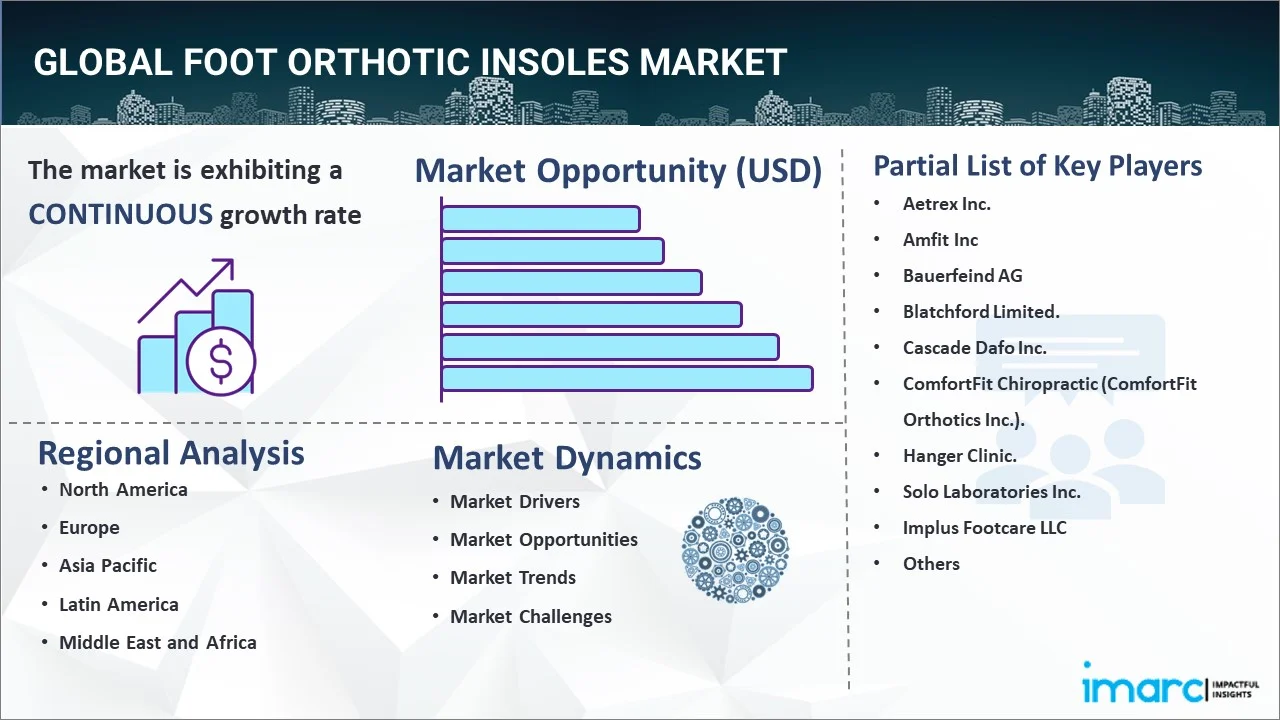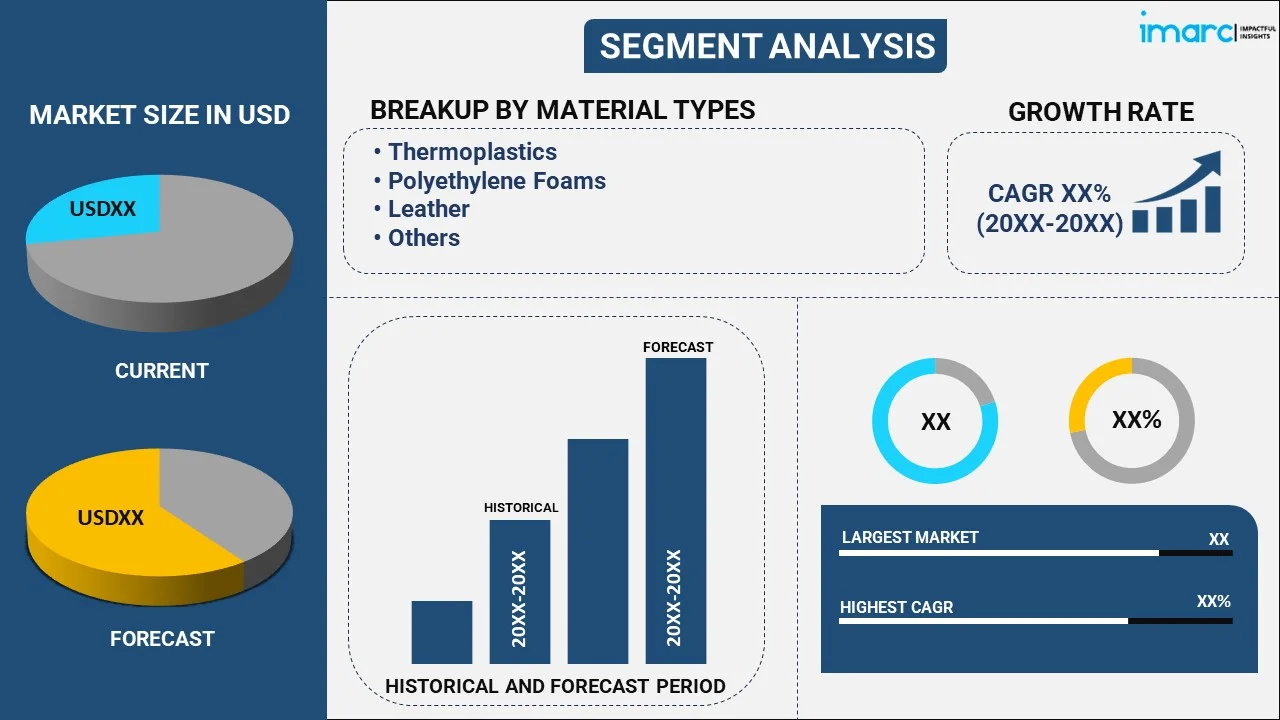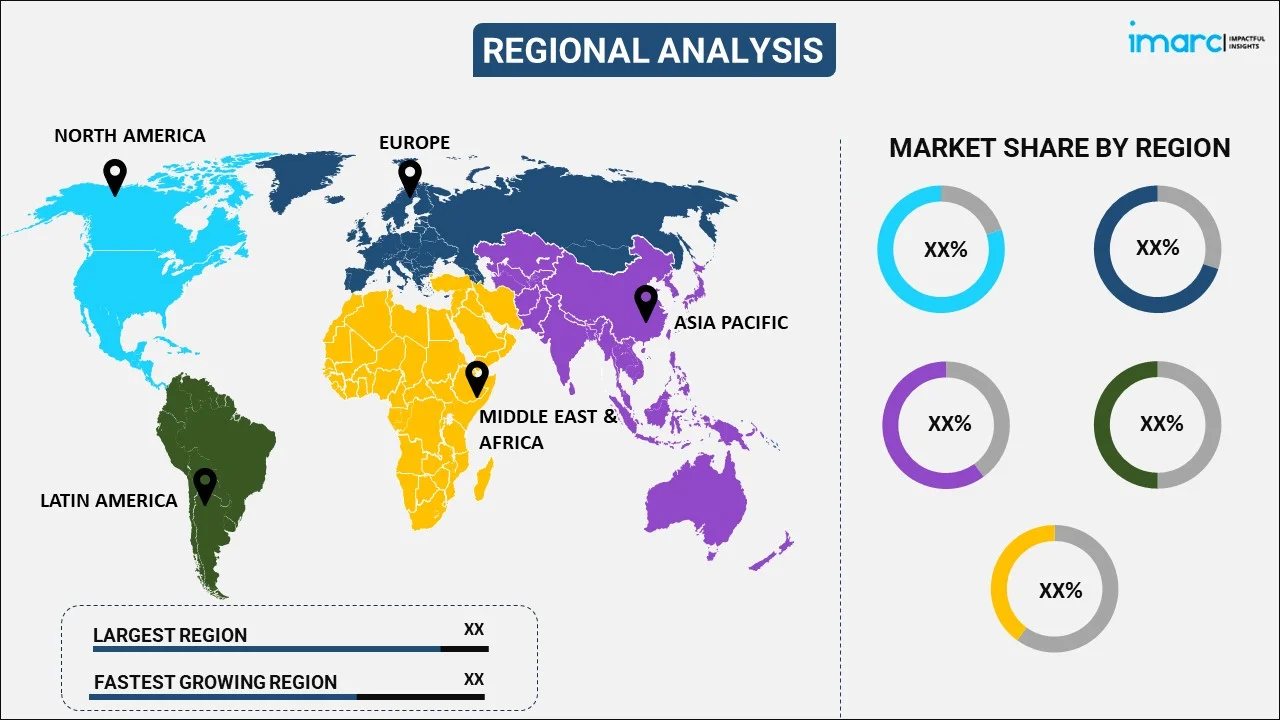
Foot Orthotic Insoles Market Report by Material Type (Thermoplastics, Polyethylene Foams, Leather, Cork, Composite Carbon Fibers, and Others), Product (Prefabricated, Customized), Application (Sports and Athletics, Medical, and Others), Distribution Channel (Drug Stores, Hospitals and Specialty Clinics, Online Stores, and Others), and Region 2025-2033
Market Overview:
The global foot orthotic insoles market size reached USD 3.6 Million in 2024. Looking forward, IMARC Group expects the market to reach USD 7.1 Million by 2033, exhibiting a growth rate (CAGR) of 7.08% during 2025-2033. Increasing foot-related disorders, the rising awareness about foot health and its impact on overall well-being fuels consumer interest, burgeoning aging population and their susceptibility to foot ailments, a growing sports culture, and advancements in material technology are factors propelling the market growth. At present, North America holds the largest market share, driven by increasing prevalence of foot-related disorders.
|
Report Attribute
|
Key Statistics
|
|---|---|
|
Base Year
|
2024
|
|
Forecast Years
|
2025-2033
|
|
Historical Years
|
2019-2024
|
|
Market Size in 2024
|
USD 3.6 Million |
|
Market Forecast in 2033
|
USD 7.1 Million |
| Market Growth Rate 2025-2033 | 7.08% |
Foot orthotic insoles are specialized inserts designed to provide support and alleviate discomfort in the feet, making them a crucial tool in enhancing foot health. They are crafted to address various biomechanical issues, offering benefits such as improved posture, reduced pain, and enhanced overall comfort during daily activities. With applications spanning across both medical and lifestyle domains, foot orthotic insoles are commonly used to manage conditions such as plantar fasciitis, flat feet, and pronation-related issues. Furthermore, they aid in distributing pressure evenly across the feet, thereby preventing the development of calluses and pressure sores. The diverse range of foot orthotic insole types includes accommodative insoles, designed to provide cushioning and alleviate pressure; functional insoles, focused on correcting alignment and gait issues; and rigid insoles, offering substantial support for structural concerns.

The global foot orthotic insoles market is influenced by the increasing prevalence of foot-related disorders and conditions, such as plantar fasciitis and flat feet, which have driven the demand for orthotic insoles as a non-invasive solution for pain relief and enhanced comfort. Additionally, the rising awareness among consumers about the importance of foot health and its impact on overall well-being is supporting the market growth. Furthermore, the burgeoning aging population, characterized by a higher susceptibility to foot ailments, contributes significantly to market growth. Moreover, the growing sports and fitness culture worldwide fuels the demand for specialized orthotic insoles designed to prevent injuries and optimize athletic performance, which is augmenting the market growth. In line with this, advancements in material technologies and manufacturing processes enable the development of innovative and customized insoles, further boosting market growth.
Foot Orthotic Insoles Market Trends/Drivers:
Increasing prevalence of foot-related disorders
The global foot orthotic insoles market is propelled by a substantial increase in the prevalence of foot-related disorders, prominently including conditions like plantar fasciitis and flat feet. These ailments can result in discomfort and diminished mobility, leading individuals to seek effective solutions for pain relief and enhanced comfort. Orthotic insoles have gained prominence as a non-invasive remedy, offering support and alignment to the feet. As more individuals experience these disorders due to factors like lifestyle changes, aging, and weight fluctuations, the demand for orthotic insoles is expected to rise steadily. The market's growth is intrinsically tied to addressing the needs of individuals afflicted with such conditions, providing them with accessible solutions that enhance their overall well-being.
Growing awareness of foot health
The escalating awareness among consumers about the importance of foot health and its impact on overall wellness significantly contributes to the expansion of the foot orthotic insoles market. As individuals recognize the connection between foot comfort, posture, and overall body alignment, the demand for products that address these concerns surges. Consumers are increasingly seeking preventive measures to avoid foot-related ailments and discomfort. This awareness is further augmented by educational campaigns, healthcare professionals, and media outlets emphasizing the significance of maintaining healthy feet. Orthotic insoles are being recognized as a proactive approach to maintaining foot health, which translates into an expanding consumer base actively seeking these solutions.
Aging population and foot ailments
The aging global population represents a substantial driver for the foot orthotic insoles market. With age, the risk of developing various foot ailments, such as arch pain and plantar fasciitis, increases. Older individuals are particularly vulnerable due to factors like decreased muscle strength, thinner fat padding, and reduced elasticity of ligaments. As this demographic continues to expand, the demand for orthotic insoles that provide comfort, support, and pain relief rises proportionately. Manufacturers are addressing the specific needs of seniors by designing insoles that alleviate age-related foot discomfort, fostering independence and an active lifestyle. This synergy between the aging population's requirements and the benefits offered by orthotic insoles underlines their growing significance in the market landscape.
Foot Orthotic Insoles Industry Segmentation:
IMARC Group provides an analysis of the key trends in each segment of the global foot orthotic insoles market report, along with forecasts at the global, regional and country levels from 2025-2033. Our report has categorized the market based on material type, product, application and distribution channel.
Breakup by Material Type:

- Thermoplastics
- Polyethylene Foams
- Leather
- Cork
- Composite Carbon Fibers
- Others
Polyethylene foams dominate the market
The report has provided a detailed breakup and analysis of the market based on the material type. This includes thermoplastics, polyethylene foams, leather, cork, composite carbon fibers, and others. According to the report, polyethylene foams represented the largest segment.
The growth of the polyethylene foams segment is attributed to several key factors, including the exceptional versatility and lightweight nature of polyethylene foams make them highly sought-after materials across various industries, including packaging, construction, automotive, and consumer goods. Additionally, the material's superior insulation properties contribute to its increasing use in applications requiring thermal and sound insulation, further augmenting demand. The growing emphasis on sustainability and environmental considerations aligns well with polyethylene foams, as they are recyclable and energy-efficient to produce. Moreover, the burgeoning e-commerce sector's demand for protective packaging solutions has bolstered the adoption of polyethylene foams to safeguard products during transit. As industries continue to prioritize cost-effectiveness, durability, and efficiency, the polyethylene foams segment is poised for sustained growth due to its ability to address these multifaceted demands effectively. This trend is further transforming the foot orthotic insoles market outlook.
Breakup by Product:
- Prefabricated
- Customized
Prefabricated holds the largest share in the market
A detailed breakup and analysis of the market based on the product has also been provided in the report. This includes prefabricated and customized. According to the report, prefabricated represented the largest segment.
The prefabricated segment of the foot orthotic insoles market is experiencing substantial growth due to the increasing prevalence of foot-related disorders has led to a higher demand for prompt and accessible solutions. Prefabricated insoles offer a convenient option for individuals seeking immediate relief from discomfort and pain. Furthermore, advancements in material technologies have enabled the production of prefabricated insoles with enhanced cushioning, arch support, and shock absorption properties, addressing specific foot conditions effectively. Moreover, the growing awareness of foot health among consumers has amplified the demand for preventive measures, with prefabricated insoles being perceived as a proactive choice. Additionally, the availability of prefabricated insoles across various distribution channels, including retail stores and online platforms, has expanded their reach, offering consumers a wider selection. In line with this, cost-effectiveness and ease of accessibility further contribute to the surge in demand for prefabricated foot orthotic insoles, driving the growth of this segment in the market.
Breakup by Application:
- Sports and Athletics
- Medical
- Others
Medical dominates the market
The report has provided a detailed breakup and analysis of the market based on the medical. This includes sports and athletics, medical, and others. According to the report, medical represented the largest segment.
The growth of the medical segment in the foot orthotic insoles market is propelled by the increasing prevalence of chronic foot-related conditions and musculoskeletal disorders, such as plantar fasciitis and diabetic neuropathy, necessitates effective therapeutic interventions. Orthotic insoles offer pain relief, support, and proper alignment, addressing these medical concerns. FUrthermore, the expanding aging population, characterized by a higher susceptibility to foot ailments due to physiological changes, drives the demand for orthotic solutions that enhance mobility and mitigate discomfort. Moreover, the growing awareness among healthcare professionals about the benefits of orthotic insoles as conservative treatment options further contributes to market growth. The integration of advanced materials and technologies allows for the development of specialized insoles catering to specific medical needs, such as pressure redistribution and biomechanical correction. As these factors align, the medical segment is poised to witness sustained expansion, offering essential relief and improved quality of life for individuals dealing with various foot-related medical issues.
Breakup by Distribution Channel:
- Drug Stores
- Hospitals and Specialty Clinics
- Online Stores
- Others
Hospitals and specialty clinics hold the largest share in the market
A detailed breakup and analysis of the market based on the distribution channel has also been provided in the report. This includes drug stores, hospitals and specialty clinics, online stores, and others. According to the report, hospitals and specialty clinics represented the largest segment.
The growth of the hospitals and specialty clinics segment in the healthcare industry is influenced by several key factors, including the increasing prevalence of chronic diseases and complex medical conditions necessitates specialized care that hospitals and specialty clinics are well-equipped to provide. This growing patient demand for focused and advanced medical attention propels the expansion of this segment. Furthermore, technological advancements and medical innovations drive the need for cutting-edge facilities, equipment, and expertise that hospitals and specialty clinics can offer. The integration of advanced diagnostic tools, minimally invasive procedures, and specialized treatments reinforces the growth of this segment. In line with this, collaborations between healthcare institutions and research organizations enhance the development of groundbreaking therapies, attracting patients seeking novel treatments. Apart from this, the aging population contributes to the demand for specialized care, as elderly individuals often require tailored medical services for age-related conditions.
Breakup by Region:

- North America
- United States
- Canada
- Asia-Pacific
- China
- Japan
- India
- South Korea
- Australia
- Indonesia
- Others
- Europe
- Germany
- France
- United Kingdom
- Italy
- Spain
- Russia
- Others
- Latin America
- Brazil
- Mexico
- Others
- Middle East and Africa
North America exhibits a clear dominance, accounting for the largest foot orthotic insoles market share
The report has also provided a comprehensive analysis of all the major regional markets, which include North America (the United States and Canada); Europe (Germany, France, the United Kingdom, Italy, Spain, Russia, and others); Asia Pacific (China, Japan, India, South Korea, Australia, Indonesia, and others); Latin America (Brazil, Mexico, and others); and the Middle East and Africa. According to the report, North America represented the largest segment.
The North American foot orthotic insoles market experiences dynamic growth driven by the rising prevalence of foot-related disorders, such as plantar fasciitis and bunions, among the region's population fuels the demand for orthotic insoles as effective non-invasive remedies. Moreover, the surging awareness about the importance of foot health, bolstered by educational campaigns and healthcare initiatives, propels consumers to seek orthotic solutions for comfort and pain relief. Furthermore, the region's geriatric population, susceptible to foot discomfort and conditions, intensifies the demand for orthotic insoles catering to age-related needs. In line with this, North America's robust sports and fitness culture drives the requirement for specialized insoles that aid in injury prevention and enhance athletic performance. Additionally, technological advancements in materials and manufacturing processes foster the development of innovative, customized insole products. Other factors, such as the escalating prevalence of e-commerce platforms and collaborations between orthotic manufacturers and healthcare professionals are promoting market growth.
Competitive Landscape:
The competitive landscape of the global foot orthotic insoles market is characterized by a dynamic interplay of various factors. As consumer awareness about foot health rises, the demand for high-quality orthotic insoles intensifies, prompting companies to innovate and offer tailored solutions. Technological advancements in materials and manufacturing processes enable the creation of innovative products that cater to individual needs. The market's growth is further driven by the integration of smart technologies, such as IoT-enabled insoles for gait analysis, providing valuable insights for both consumers and healthcare professionals.
E-commerce platforms facilitate convenient accessibility to a broad range of orthotic insole offerings, expanding market reach. Collaborations with healthcare practitioners strengthen product recommendations and enhance market penetration. As players strive to differentiate themselves through product quality, customization, and strategic partnerships, the competitive landscape of the foot orthotic insoles market continues to evolve in response to evolving consumer demands and technological progress.
The report has provided a comprehensive analysis of the competitive landscape in the market. Detailed profiles of all major companies have also been provided. Some of the key players in the market include:
- Aetrex Inc.
- Amfit Inc.
- Bauerfeind AG.
- Blatchford Limited.
- Cascade Dafo Inc.
- ComfortFit Chiropractic (ComfortFit Orthotics Inc.).
- Hanger Clinic.
- Solo Laboratories Inc.
- Implus Footcare LLC
- Superfeet Worldwide Inc.
Recent Developments:
- In February 2023, Cascade Dafo Inc. introduced five new transfer designs, which include sports paraphernalia, dinos, and Hawaiian flowers.
- In October 2018, - Implus announced the acquisition of RockTape®, a leading provider of medical education, kinesiology tape, and other health and wellness products.
- In July 2023, The Hanger Foundation awarded its first round of 2023 Empowerment Grants, giving a total of USD127,500 to 14 non-profit organizations.
Foot Orthotic Insoles Market Report Scope:
| Report Features | Details |
|---|---|
| Base Year of the Analysis | 2024 |
| Historical Period | 2019-2024 |
| Forecast Period | 2025-2033 |
| Units | Million USD |
| Scope of the Report | Exploration of Historical Trends and Market Outlook, Industry Catalysts and Challenges, Segment-Wise Historical and Predictive Market Assessment:
|
| Material Types Covered | Thermoplastics, Polyethylene Foams, Leather, Cork, Composite Carbon Fibers, Others |
| Products Covered | Prefabricated Customized |
| Applications Covered | Sports and Athletics, Medical, Others |
| Distribution Channels Covered | Drug Stores, Hospitals and Specialty Clinics, Online Stores, Others |
| Regions Covered | Asia Pacific, Europe, North America, Latin America, Middle East and Africa |
| Countries Covered | United States, Canada, Germany, France, United Kingdom, Italy, Spain, Russia, China, Japan, India, South Korea, Australia, Indonesia, Brazil, Mexico |
| Companies Covered | Aetrex Inc., Amfit Inc, Bauerfeind AG, Blatchford Limited, Cascade Dafo Inc., ComfortFit Chiropractic (ComfortFit Orthotics Inc.), Hanger Clinic, Solo Laboratories Inc., Implus Footcare LLC, Superfeet Worldwide Inc., etc. |
| Customization Scope | 10% Free Customization |
| Post-Sale Analyst Support | 10-12 Weeks |
| Delivery Format | PDF and Excel through Email (We can also provide the editable version of the report in PPT/Word format on special request) |
Key Benefits for Stakeholders:
- IMARC’s industry report offers a comprehensive quantitative analysis of various market segments, historical and current market trends, market forecasts, and dynamics of the foot orthotic insoles market from 2019-2033.
- The research report provides the latest information on the market drivers, challenges, and opportunities in the global foot orthotic insoles market.
- The study maps the leading, as well as the fastest-growing, regional markets. It further enables stakeholders to identify the key country-level markets within each region.
- Porter's five forces analysis assist stakeholders in assessing the impact of new entrants, competitive rivalry, supplier power, buyer power, and the threat of substitution. It helps stakeholders to analyze the level of competition within the foot orthotic insoles industry and its attractiveness.
- Competitive landscape allows stakeholders to understand their competitive environment and provides an insight into the current positions of key players in the market.
Key Questions Answered in This Report
The foot orthotic insoles market was valued at USD 3.6 Million in 2024.
The foot orthotic insoles market is projected to exhibit a CAGR of 7.08% during 2025-2033, reaching a value of USD 7.1 Million by 2033.
The market is supported by rising cases of foot disorders like plantar fasciitis, growing public awareness of foot health, and increased demand from the aging population. Sports and fitness trends are also boosting demand for performance-enhancing and injury-preventive insoles. Material innovations, improved manufacturing techniques, and broader access through retail and e-commerce channels are further propelling growth.
North America currently dominates the foot orthotic insoles market, driven by high foot disorder prevalence, consumer awareness, aging demographics, and a well-established sports and healthcare infrastructure.
Some of the major players in the foot orthotic insoles market include Aetrex Inc., Amfit Inc., Bauerfeind AG, Blatchford Limited, Cascade Dafo Inc., ComfortFit Chiropractic (ComfortFit Orthotics Inc.), Hanger Clinic, Solo Laboratories Inc., Implus Footcare LLC, and Superfeet Worldwide Inc.
Need more help?
- Speak to our experienced analysts for insights on the current market scenarios.
- Include additional segments and countries to customize the report as per your requirement.
- Gain an unparalleled competitive advantage in your domain by understanding how to utilize the report and positively impacting your operations and revenue.
- For further assistance, please connect with our analysts.
 Request Customization
Request Customization
 Speak to an Analyst
Speak to an Analyst
 Request Brochure
Request Brochure
 Inquire Before Buying
Inquire Before Buying




.webp)




.webp)












